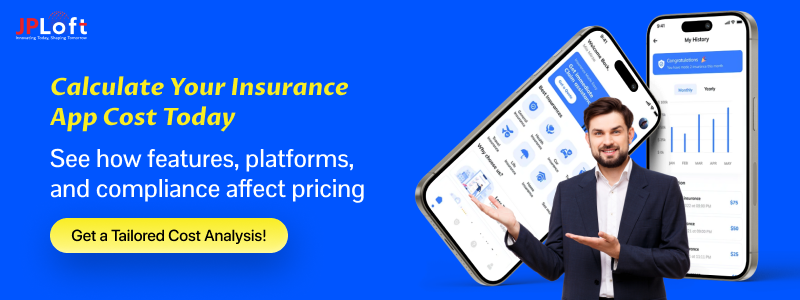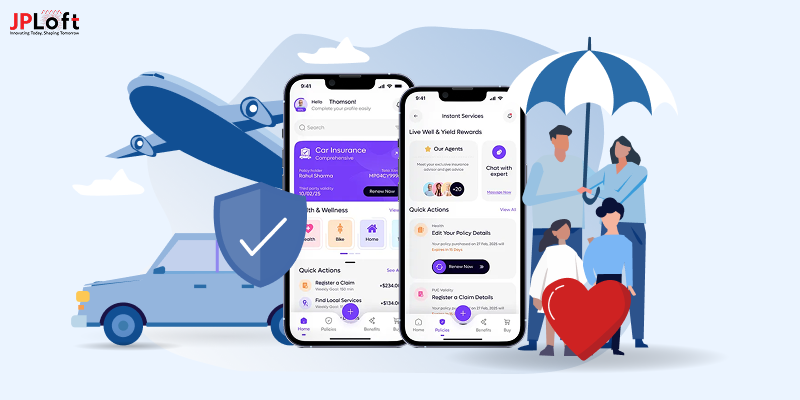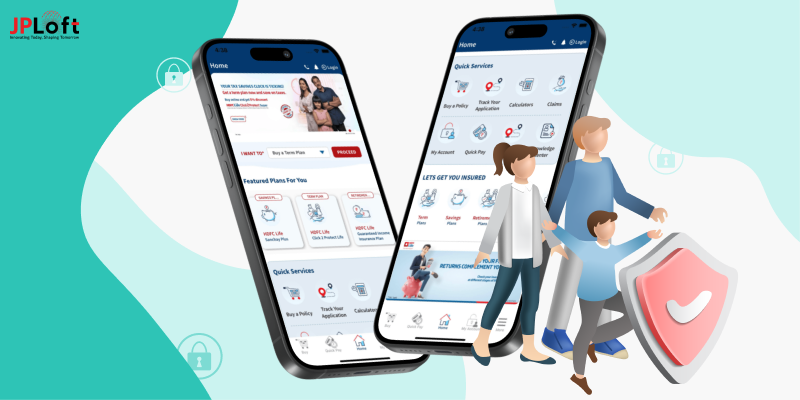The demand for digital insurance solutions is growing rapidly, with businesses and startups alike exploring new opportunities in this sector.
One of the most common questions entrepreneurs ask is, “What’s the cost to create an insurance app?” On average, the cost ranges from $40,000 to $200,000 or more, depending on factors like app complexity, features, and the chosen technology stack.
Understanding the financial aspects before beginning development helps businesses plan realistically and avoid unexpected expenses.
This blog serves as a complete guide to the cost to make an insurance app, breaking down pricing factors, ways to reduce expenses, and monetization strategies.
By the end, you’ll have clear insights into the insurance app development cost and what it takes to build a competitive, future-ready solution.
Key Takeaways
Understanding the cost to create an insurance app is crucial for budgeting and planning a successful digital solution, with development typically ranging between $40,000 and $200,000+.
App complexity, features, AI integration, design, and platform choice are major factors impacting development cost.
Starting with an MVP and prioritizing core features can significantly reduce the overall cost to build an insurance app.
Monetization strategies such as freemium, subscriptions, in-app ads, commissions, and partnerships help maximize ROI.
Early planning with wireframing and prototyping ensures optimal user experience and cost efficiency.
Partnering with an experienced team like JPLoft ensures robust features, scalability, and faster time-to-market.
All About Insurance App, and Related Market Stats
An insurance app is a digital platform that allows policyholders to manage their policies, file claims, pay premiums, and access support seamlessly from their smartphones.
These apps combine features like policy comparison, real-time claim tracking, chatbot support, and AI-driven fraud detection to provide convenience and transparency.
Businesses building such solutions aim to deliver faster services, boost customer loyalty, and reduce operational costs.
A] Related Market Stats & Insights
-
Global growth: The global digital insurance platform market is projected to reach $279.51 billion by 2030, growing at a CAGR of nearly 11.3%.
-
Mobile adoption: More than 65% of insurance customers prefer using mobile apps over web portals for managing their policies.
-
AI influence: Around 42% of insurers are investing in AI-powered apps to improve claims processing and customer personalization.
-
User demand: A survey revealed that 64% of policyholders switch providers if they don’t get access to digital-first solutions.
B] Why Insurance Apps Matter?
These statistics highlight that investing in an insurance app is no longer optional; it’s a necessity for insurers aiming to remain competitive.
Businesses often wonder about the cost to create an insurance app, and while the investment may vary, the returns in customer satisfaction and retention are significant.
Moreover, the average cost to develop an insurance app depends on features like AI chatbots, fraud detection systems, or telematics integration, which directly impact efficiency and trust.
From simple policy management tools to advanced apps powered by predictive analytics, the possibilities are vast.
For entrepreneurs exploring how to build an insurance app, focusing on user-centric features and compliance from the start is crucial.
Many innovative insurance app ideas, like personalized recommendations or IoT-driven policy adjustments, are already disrupting the market.
Whether you’re a startup or an established insurer aiming to create a mobile app for your customers, understanding this space is the first step toward success.
What’s the Cost to Create an Insurance App?
The cost to create an insurance app generally ranges between $40,000 and $250,000+, depending on the app’s complexity, features, and platform choice.
A basic app with core functions like policy management and reminders may sit at the lower end of the spectrum, while advanced apps with AI-driven fraud detection, predictive analytics, and real-time claim processing require a much higher budget.
Design quality, backend infrastructure, compliance with industry regulations, and scalability options also influence the final investment.
Additionally, native development for iOS and Android costs more compared to cross-platform solutions.
Partnering with an experienced development team ensures you strike the right balance between innovation, usability, and regulatory compliance, making the investment worthwhile.
Ultimately, the mobile app development cost is not just about building the product; it’s about ensuring security, performance, and customer satisfaction in a highly competitive insurance market.
Here is the cost breakdown:
|
App Type / Complexity |
Features Included |
Estimated Cost (USD) |
Timeline |
|
Basic App |
Policy viewing, premium reminders, and profile management |
$40,000 – $40,000 |
3–4 months |
|
Mid-Level App |
Claims management, document upload, and in-app chat support |
$45,000 – $70,000 |
5–7 months |
|
Advanced App |
AI chatbots, fraud detection, telematics, analytics |
$75,000 – $250,000+ |
8–12 months |
This gives you an idea of the development cost of an insurance app across different levels of complexity.
Factors Impacting the Cost to Make an Insurance App
When calculating the overall cost to build an insurance app, multiple aspects come into play. Below are the top factors that influence pricing, each with a direct impact on your budget.
1. App Complexity
The complexity of an insurance app is one of the primary cost determinants. A basic app with essential features like premium reminders or simple policy lookup requires fewer resources and can be developed at a much lower cost.
However, as complexity increases, so do the technical requirements, timelines, and budgets.
How it impacts cost:
-
Basic Complexity: Ideal for startups or pilot projects. Lower initial investment, but limited scalability.
-
Medium Complexity: Balances functionality and cost with features like document uploads, claims tracking, or multilingual support.
-
High Complexity: Includes advanced modules such as AI chatbots, fraud detection, or telematics-based pricing. These demand skilled developers and rigorous testing cycles.
|
Complexity Level |
Example Features |
Estimated Cost Range |
|
Basic |
Premium reminders, policy lookup |
$40,000 – $60,000 |
|
Medium |
Document uploads, claims tracking, and multilingual support |
$60,000 – $120,000 |
|
High |
AI chatbots, fraud detection, and telematics |
$120,000 – $200,000+ |
2. Number of Features
Each additional feature added to the app increases development effort and expenses.
While a minimal app may only handle policy details, adding extra modules such as claims tracking, digital ID verification, or video consultations can significantly raise costs. Businesses often underestimate how quickly feature requests stack up and impact the budget.
How it impacts cost:
-
Core Features: Policy management, premium payments, and claim submission remain cost-efficient.
-
Additional Features: Multi-language support, chatbot integration, and digital uploads increase development timelines.
-
Advanced Features: Personalized dashboards, video consultations, and AI-powered insights can double the overall cost.
|
Feature Set |
Example Modules |
Estimated Cost Impact |
|
Core |
Policy management, claim submission |
+$10,000 – $25,000 |
|
Additional |
Multi-language support, chatbot, digital uploads |
+$20,000 – $50,000 |
|
Advanced |
Video consultations, AI dashboards |
+$50,000 – $80,000+ |
3. Design & User Interface
The design of an insurance app directly affects both user adoption and development costs.
A clean, user-friendly design with intuitive navigation boosts engagement but requires professional designers and additional development hours.
Elements such as animations, custom icons, and polished transitions increase overall costs but also elevate the user experience.
How it impacts cost:
-
Basic Design: Minimal UI with standard components, affordable but may feel outdated.
-
Intermediate Design: Custom layouts, icons, and responsive screens, balanced cost with high usability.
-
Advanced Design: Includes animations, micro-interactions, and personalized user flows, more expensive but leads to higher engagement.
|
Design Level |
Features Included |
Estimated Cost Range |
|
Basic |
Standard UI, limited customization |
$5,000 – $15,000 |
|
Intermediate |
Custom icons, responsive layouts |
$15,000 – $30,000 |
|
Advanced |
Animations, micro-interactions, advanced branding |
$30,000 – $50,000+ |
4. Technology Stack
The choice of technology stack significantly influences both performance and cost.
A backend built with scalable frameworks like Node.js or Django paired with cloud hosting ensures flexibility, while AI libraries add automation capabilities.
However, selecting premium tools or proprietary solutions can increase upfront expenses. Many businesses consult a mobile app development company in UK to identify the most efficient stack for their specific project.
How it impacts cost:
-
Open-Source Tools: Lower licensing costs but may require additional setup.
-
Cloud Hosting: Scalable but adds recurring fees.
-
AI Libraries: Higher initial investment but save long-term operational costs.
|
Stack Type |
Examples |
Cost Impact |
|
Open Source |
MySQL, Firebase, React Native |
Lower upfront cost |
|
Premium/Proprietary |
Microsoft Azure, Oracle |
Higher licensing cost |
|
AI Integration |
TensorFlow, PyTorch |
+$20,000 – $50,000 |
5. Platform Choice
Platform selection plays a direct role in development pricing. Building native apps for both iOS and Android separately increases costs due to dual coding and testing requirements.
On the other hand, cross-platform frameworks like Flutter or React Native allow one codebase to run on both platforms, cutting costs while maintaining performance.
How it impacts cost:
-
iOS Development: Higher costs due to stricter guidelines and fewer reusable components.
-
Android Development: Larger user base, but requires optimization for multiple device types.
-
Cross-Platform: More cost-efficient and reduces time-to-market without compromising on most features.
|
Platform Choice |
Pros |
Cons |
Estimated Cost |
|
iOS (Native) |
Secure, stable |
Expensive |
$40,000 – $70,000 |
|
Android (Native) |
Wider reach |
Device fragmentation |
$35,000 – $65,000 |
|
Cross-Platform |
One codebase, cost-efficient |
Slightly less native performance |
$50,000 – $80,000 |
6. Integration with Third-Party Services
Insurance apps often rely on third-party integrations such as payment gateways, CRM systems, KYC verification, or regulatory APIs.
These integrations speed up functionality but can add significant expenses depending on complexity and licensing requirements. For example, integrating a secure payment solution requires compliance checks and additional testing.
How it impacts cost:
-
Payment Gateways: Essential but may include transaction fees and compliance costs.
-
CRM Integration: Adds value for customer management but increases development hours.
-
Regulatory APIs: Complex and must align with data security standards, raising overall costs.
|
Integration Type |
Examples |
Cost Impact |
|
Payment Gateway |
Stripe, PayPal |
+$5,000 – $15,000 |
|
CRM System |
Salesforce, HubSpot |
+$10,000 – $20,000 |
|
Regulatory APIs |
KYC, AML, GDPR compliance |
+$15,000 – $30,000 |
7. Security & Compliance
Security and compliance are non-negotiable in insurance apps.
Meeting standards like GDPR, HIPAA, or local insurance regulations ensures data protection but requires advanced encryption, secure authentication, and regular audits.
These measures not only add to the development cost but also require specialized expertise.
How it impacts cost:
-
Data Encryption: Protects sensitive policyholder data but increases development hours.
-
Regulatory Compliance: Requires legal consultation and extra testing cycles.
-
Advanced Authentication: Multi-factor authentication or biometric security raises integration expenses.
|
Security/Compliance Area |
Example Requirements |
Cost Impact |
|
Data Encryption |
AES-256, SSL/TLS |
+$10,000 – $20,000 |
|
Compliance Standards |
GDPR, HIPAA, ISO |
+$15,000 – $40,000 |
|
Authentication Systems |
Biometrics, OTPs |
+$5,000 – $15,000 |
8. Artificial Intelligence & Automation
AI is transforming the insurance industry by enabling predictive analytics, fraud detection, and automated claims processing.
Integrating these features requires advanced libraries, machine learning models, and extensive testing, all of which raise development costs.
However, AI also improves efficiency and long-term ROI. Businesses that want advanced features often work with the best mobile app development company to ensure AI is implemented seamlessly.
How it impacts cost:
-
Predictive Analytics: Helps assess risk but requires large datasets and AI models.
-
Fraud Detection: Adds complexity to the backend but reduces financial losses.
-
Claims Automation: Streamlines user experience yet demands heavy AI integration.
|
AI Feature |
Example Use Case |
Cost Impact |
|
Predictive Analytics |
Risk assessment, premium calculation |
+$20,000 – $40,000 |
|
Fraud Detection |
Identifying fraudulent claims |
+$25,000 – $50,000 |
|
Claims Automation |
Automated claim approval workflows |
+$30,000 – $60,000 |
9. Testing & Quality Assurance
Rigorous testing ensures the app performs smoothly across devices, platforms, and user scenarios.
While manual testing identifies usability issues, automated QA tools speed up the process and reduce long-term maintenance costs. Still, both approaches require investment, making testing a critical cost factor.
How it impacts cost:
-
Manual Testing: Best for usability and design validation but time-intensive.
-
Automated Testing: Higher upfront costs but reduces post-launch bug fixes.
-
Performance Testing: Ensures the app runs efficiently even under heavy usage.
|
Testing Type |
Purpose |
Cost Impact |
|
Manual Testing |
Usability, design validation |
+$10,000 – $20,000 |
|
Automated QA |
Faster, scalable testing |
+$15,000 – $30,000 |
|
Performance Testing |
Load testing, stress testing |
+$10,000 – $25,000 |
10. Development Team & Location
The team you choose and their geographical location significantly influence costs.
Hiring US or Western Europe-based developers is more expensive due to higher hourly rates, while outsourcing to Asia or Eastern Europe offers affordability without necessarily compromising quality.
Many businesses reduce expenses by balancing in-house management with offshore development.
How it impacts cost:
-
Local Teams: Easier communication, but higher hourly rates.
-
Offshore Teams: Lower costs, though time zones and cultural differences may require adjustments.
-
Hybrid Model: Core management in-house with offshore developers for cost savings.
|
Team Location |
Average Hourly Rate |
Cost Impact |
|
US/Western Europe |
$80 – $150/hr |
Highest |
|
Eastern Europe |
$40 – $70/hr |
Moderate |
|
Asia (India, etc.) |
$20 – $50/hr |
Lowest |
11. Post-Launch Support & Updates
Development doesn’t end after launch; consistent updates, bug fixes, and new features are crucial for long-term success.
Without ongoing support, user satisfaction can drop quickly. Partnering with professional mobile app maintenance services ensures stability and reduces the risk of unexpected failures.
How it impacts cost:
-
Bug Fixes: Regular patches prevent small issues from escalating.
-
Feature Updates: Keeps the app competitive but adds recurring costs.
-
Scalability Enhancements: Optimizing for more users and features raises long-term expenses.
|
Support Type |
Purpose |
Estimated Annual Cost |
|
Bug Fixes |
Stability, security |
$5,000 – $15,000 |
|
Feature Updates |
Staying competitive |
$10,000 – $30,000 |
|
Scalability Enhancements |
Preparing for growth |
$15,000 – $40,000+ |
12. Marketing & Launch Strategy
Even the best insurance app won’t succeed without proper marketing.
Allocating a budget for app store optimization, digital ads, and influencer campaigns is crucial.
Pre-launch strategies such as beta testing and pilot rollouts also help refine the app while reducing post-launch costs.
How it impacts cost:
-
App Store Optimization (ASO): Improves visibility but requires ongoing investment.
-
Paid Ads & Campaigns: Drive quick downloads but can be costly at scale.
-
Beta Testing & Soft Launch: Saves costs later by gathering early feedback.
|
Marketing Strategy |
Example Activities |
Cost Range |
|
ASO |
Keywords, reviews, optimization |
$2,000 – $10,000 |
|
Paid Campaigns |
Google Ads, social ads |
$10,000 – $50,000 |
|
Beta Testing/Soft Launch |
Pilot users, feedback gathering |
$5,000 – $15,000 |
Final Note on Factors
From app complexity and features to compliance, integrations, and post-launch support, every decision affects the overall cost to make an insurance app.
Businesses that carefully analyze these elements upfront avoid budget overruns and ensure smoother execution. By striking the right balance between technology, features, and long-term planning, companies can maximize ROI while delivering a high-quality insurance solution.
Practices to Reduce the Overall Cost to Build an Insurance App
Every business wants a feature-rich app without overspending. The overall cost to build an insurance app can be optimized by following smart strategies that balance functionality with efficiency. Here are some proven practices:
1. Start with an MVP (Minimum Viable Product)
Launching with an MVP allows businesses to test the market quickly using only essential features.
Instead of investing heavily in a fully-featured app upfront, an MVP lets you validate your idea, understand user preferences, and gather actionable feedback.
For companies looking to create an AI app, starting with a minimum viable version ensures that AI features are tested effectively without excessive initial costs.
This approach significantly reduces development expenses and avoids the risk of spending on features that users may not value.
2. Prioritize Core Features First
Focusing on essential features such as policy management, claim submission, and premium reminders ensures the app addresses the most critical user needs without adding unnecessary complexity.
By implementing advanced or niche functionalities in later phases, businesses can streamline development and allocate resources more efficiently.
This approach not only optimizes the workflow but also accelerates timelines, enabling faster market entry and early revenue generation while maintaining a high-quality user experience.
3. Leverage Pre-Built Modules
Integrating pre-built modules like payment gateways, authentication systems, and third-party APIs can dramatically reduce development time and costs.
Instead of building every component from scratch, these modules offer tested, secure, and scalable solutions.
Businesses using AI app development services can access pre-built AI tools and APIs for features like predictive analytics or chatbots, saving time and reducing implementation costs. Pre-built components also simplify maintenance and ensure faster delivery.
4. Outsource to Reliable Partners
Partnering with an experienced on-demand app development company rather than maintaining a large in-house team can significantly reduce expenses.
Outsourcing provides access to skilled developers, designers, and QA experts who bring industry knowledge and proven workflows.
Companies that want to hire dedicated developers for complex AI features or backend integrations benefit from specialized expertise without the overhead of permanent hires.
A reliable partner also accelerates the development timeline, helping you reach the market faster.
5. Adopt Agile Development
Agile methodology emphasizes iterative releases and continuous improvement, reducing the risk of overspending on features that may not perform well.
By breaking development into smaller sprints, teams can adapt quickly to changing requirements and market feedback.
This prevents costly rework and ensures that resources are allocated to features that genuinely enhance user experience.
Agile also promotes collaboration between stakeholders, developers, and QA teams, making the development process more transparent and efficient.
6. Use Cross-Platform Frameworks
Instead of building separate native apps for iOS and Android, frameworks like Flutter or React Native allow a single codebase to run across multiple platforms.
This approach significantly cuts development time and reduces maintenance overhead.
Cross-platform frameworks also facilitate faster updates, as changes need to be implemented only once rather than twice for each platform.
7. Optimize the Mobile App Architecture
Selecting a cost-effective mobile app tech stack is critical for balancing performance with budget.
Cloud-based hosting solutions, scalable databases, and lightweight frameworks reduce infrastructure and maintenance costs while keeping the app future-ready.
Choosing open-source tools or widely supported libraries minimizes licensing fees and ensures long-term support.
A well-optimized tech stack also allows for easier integration with third-party services, saving time and development resources.
8. Plan for Post-Launch Support in Advance
Including a portion of the budget for updates, bug fixes, and feature enhancements ensures smoother post-launch operations.
Planning for post-launch support prevents sudden high expenses and avoids downtime, which can affect user trust and revenue.
Businesses should also allocate resources for monitoring analytics, gathering user feedback, and implementing incremental improvements.
Following a detailed guide to insurance app development cost ensures ongoing support is factored in, helping maintain app performance, security, and scalability.
A proactive post-launch plan balances cost management with user satisfaction and long-term app success.
Final Note on Cost Optimization
So, how much does it cost to build an insurance app? The final figure depends on your planning and execution.
By focusing on these smart development practices, businesses can save up to 30–40% on expenses without compromising quality, performance, or user experience.
How to Monetize an Insurance App?
Creating an insurance app is just one step; the next big challenge is making it profitable.
A well-defined mobile app monetization model is essential to ensure consistent revenue while delivering value to users.
Monetization strategies must align with user expectations, regulatory standards, and long-term sustainability. This section outlines practical models businesses can adopt to maximize ROI while keeping user satisfaction intact.
1. Freemium Model
The freemium approach allows users to access basic features for free while offering advanced tools like claim tracking, AI-driven risk analysis, or personalized investment advice through premium upgrades.
This model helps attract a large user base while converting a percentage into paying customers.
2. Subscription Model
Recurring subscription plans, monthly, quarterly, or yearly, offer stable income.
Users can subscribe to value-added services such as digital policy management, advanced financial dashboards, or 24/7 customer assistance.
This steady revenue helps balance the average cost to develop an insurance app and ensures long-term profitability.
3. In-App Advertising
Insurance apps can integrate targeted ads for financial products, healthcare providers, or credit services.
With the right mobile app design, ads can be displayed without hampering user experience. For example, offering banner ads during policy comparisons or native ads inside news feeds can generate consistent income streams.
4. Commissions on Policy Sales
Partnering with insurers allows app owners to earn commissions when users buy or renew policies through the platform.
This model works well for aggregator-style apps and directly addresses the entrepreneur’s question: How much does it cost to build an insurance app? The potential commission-based income can offset expenses quickly if the app secures strong partnerships.
5. Strategic Partnerships
Cross-industry collaborations open new monetization doors.
Partnering with hospitals, wellness brands, or even gyms can provide exclusive offers, with both parties sharing revenue.
Working with a mobile app development company denver ensures smooth API integrations for partnerships that enhance user engagement while boosting income.
6. ROI Connection
While considering monetization, businesses must evaluate how much does it cost to make an insurance app? and map it against potential revenue models.
For instance, subscription-based models can cover operational costs faster than freemium, while ad-based models might take longer but bring consistent passive revenue.
7. Planning for Monetization
Successful monetization begins early by integrating premium features, ad spaces, and subscriptions into the design process.
Using wireframing and prototyping, teams can visualize app structure, test user flows, and optimize monetization placement.
This approach reduces redesign costs and helps balance the cost to develop an insurance app with potential revenue opportunities.
8. Balancing Costs and Growth
A complete guide to cost to make an insurance app shows that monetization isn’t just about revenue, it’s about sustainability.
Businesses must calculate projected returns, analyze user acquisition costs, and align pricing with customer willingness to pay.
Whether through subscriptions or commissions, a well-planned strategy ensures not just break-even but scalable growth.
Build Your Insurance App In Budget With JPLoft
Determining the exact cost to make an insurance app requires a detailed understanding of your business goals, desired features, and target audience.
JPLoft, a leading insurance app development company, provides tailored consultations to help you plan a cost-effective, high-performing solution.
Whether you’re aiming for a basic policy management tool or an advanced AI-powered platform, our experts guide you through every step from feature selection to technology stack recommendations.
By partnering with JPLoft, you gain transparency in pricing, a clear roadmap, and insights to maximize ROI while keeping development within budget. Talk to us today to get your personalized cost estimate.
Conclusion
Understanding the financial aspects of building an insurance app is crucial for businesses aiming to succeed in the digital insurance space.
The answer to their question, How much does it cost to develop an insurance app? completely depends on features, design, technology stack, AI integration, and development team expertise.
By evaluating these factors and implementing cost-saving practices, businesses can optimize their budget while delivering a high-quality user experience.
Monetization strategies like freemium, subscriptions, in-app ads, and partnerships help maximize ROI and ensure sustainable growth.
Whether launching a simple policy management tool or a fully-featured AI-powered platform, careful planning and professional guidance make all the difference in controlling the cost to build an insurance app effectively.
FAQs
The cost to create an insurance app in 2025 typically ranges between $40,000 and $250,000+, depending on app complexity, features, design, platform choice, and AI integration. Basic apps with essential features are on the lower end, while advanced apps with AI-driven analytics and fraud detection are more expensive.
Key factors include app complexity, number of features, design and UI/UX, technology stack, platform choice (iOS, Android, or cross-platform), third-party integrations, security and compliance, AI implementation, testing, development team location, and post-launch support. Each element can significantly impact the final budget.
You can optimize costs by starting with an MVP, prioritizing core features first, leveraging pre-built modules, outsourcing to reliable development partners, adopting agile methodology, using cross-platform frameworks, and planning post-launch support in advance. These strategies help save up to 30–40% without compromising quality.
Popular monetization strategies include the freemium model, subscription plans, in-app advertising, commissions on policy sales, and strategic partnerships. Selecting a model that aligns with user expectations and app features ensures a sustainable revenue stream and faster ROI.
AI features like predictive analytics, fraud detection, and automated claims processing enhance user experience, improve efficiency, and increase competitiveness. However, integrating AI increases development costs, typically ranging from $20,000 to $60,000+, depending on complexity and data requirements.












Share this blog